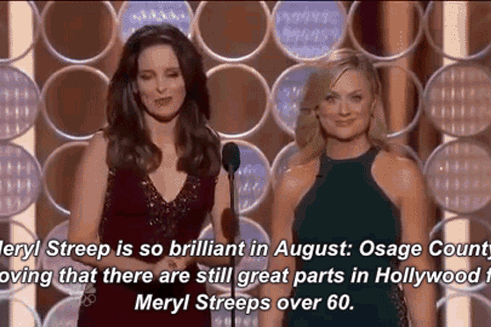Back in ye olden times of 2014, before the Golden Globes became the place for Meryl Streep sonning President Trump, it was noteworthy for a different Streep-related zinger, this one courtesy of co-hosts Tina Fey and Amy Poehler. “Meryl Streep is so brilliant in August: Osage County,” Fey said during in the pair's opening monologue, “proving that there are still great parts in Hollywood for Meryl Streeps over 60.” The audience laughed, and Streep acknowledged the remark with a knowing nod.
Now we know that not only was Fey’s joke funny—it was true.
A new study from USC’s Annenberg School for Communication and Journalism analyzed 1,256 speaking parts in 25 movies that received Best Picture Oscar nominations from 2014 to 2016. It found that only 148 (12 percent) of those characters were 60 years of age or older—and, of those 148 characters, 78 percent were men and 22 percent were women. That's 3.5 men for every woman in an already tiny category. (Streep actually wasn't among those few women, since none of her movies got a Best Picture nomination, but the sentiment stands.)
Beyond age and gender, the study—conducted by the school's Media, Diversity, and Social Change Initiative, in conjunction with healthcare provider Humana—also turned up other depressing findings. Like, for example, that 90 percent of the seniors on screen were white; none were Latino, and none were LGBTQ. Also, only one senior woman was shown having a job with clout. Another fun fact? Only one film in the set was led by a senior and there was only one person over 60 amongst ensemble casts—and those leads were both played by the same person: Michael Keaton. (In Birdman and Spotlight, if you’re wondering. Also, yes, Batman is over 60.)
When people discuss Hollywood’s struggles with diversity, those conversations tend to default to issues of race, sexuality, and gender, but Tinseltown clearly isn't doing much better with age. Seniors represent about 19 percent of the US population, but only 11 percent of the people with speaking roles in the top 100 movies of 2015. Worse, the study notes, seniors are the one group that "has not been at the center of public anger and advocacy.”
The dearth of seniors in Oscar-nominated films is especially surprising considering most Academy voters, according to one 2012 study, are over 50. Following the #OscarsSoWhite social media campaign, the group made efforts to bring in more diverse members but considering the ranks already skewed older, those efforts might not change how they vote when it comes to films that represent people across the age spectrum.
There may be a silver (haired) lining, though. In the USC study’s conclusion, the authors note that because of the recent calls for gender parity in film, the number of female characters in films has begun to increase; by 2016, a little over one-third of speaking parts were played by women. Other minority groups also got more representation in mainstream cinema last year as well, as evidenced by films like Moonlight and Hidden Figures landing in the current Best Picture pool. “These findings suggest that Hollywood is capable of making and recognizing the merits of films that reflect the reality we see off screen,” the study concluded. “However, there is still more to be done to ensure that the portrayal of seniors in movies matches the world we inhabit.”
And when that happens, the joke’s on Tina Fey.
https://www.youtube.com/watch?v=b5ZnnE1nPrQ

